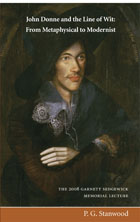John Donne and the Line of Wit: From Metaphysical to Modernist

John Donne and the Line of Wit
From Metaphysical to Modernist
by Paul G. Stanwood
$9.95
- Spring 2009
- print ISBN: 978-1-55380-065-1
- ebook ISBN: 978-1-55380-410-9
- PDF ISBN: 978-1-55380-411-6
- 5-3/4″ x 9″ Trade Paperback, 42 pages
- Literary Criticism
- Out of print
John Donne and the Line of Wit: From Metaphysical to Modernist is a study of influence, adaptation, historical imitation and invention. In his own time, Donne was celebrated for his distinctive style, especially for what his contemporaries recognized as “strong lines,” that is, witty conceits or unusual, often unexpected and surprising comparisons. Donne’s “metaphysical wit” fell out of fashion in the later seventeenth century, not to be significantly explored and revived until the early twentieth century, and then notably by the modernist movement in the years that followed Eliot’s Waste Land (1922).
Among the most important — and earliest — of poets and critics to respond to this movement are the self-styled Fugitives of the southern United States. As “fugitives” they stood against what seemed old and shop-worn language, and they gave their name and talent to the literary journal published at Vanderbilt University from 1922–25: The Fugitive provided an outlet for the work of John Crowe Ransom, Robert Penn Warren, Allen Tate, and others, who discovered a “new” modernism that might be shaped out of the “old” metaphysical mode of Donne. Their poetry is characteristically concerned with verbal or “metaphysical” invention, usually composed with metrical formality, and from an objective, detached point of view.
Paul Stanwood concludes his study with close readings of several Fugitive poems, especially Ransom’s “The Equilibrists,” which consciously recollects Donne’s “Extasie.”
Reviews:
“Stanwood’s task is to eloquently and cogently articulate the very meaning of wit and show his readers how those of Donne’s time were drawn to it and, subsequently, how it came to have a lasting impact on modernity … that Stanwood delivers on his promise in roughly thirty pages is a marvelous feat.”
—Seventeeth-Century News
Garnett Sedgewick Memorial Lectures:
- From There: Some Thoughts on Poetry & Place by Stephen Burt (2015)
- More Heat than Light: Sex-difference Science & the Study of Language by Deborah Cameron (2012)
- Marvellous Repossessions: The Tempest, Globalization and the Waking Dream of Paradise by Jonathan Gil Harris (2011)
- Living Language and Dead Reckoning: Navigating Oral and Written Traditions by J. Edward Chamberlin (2005)
- Spontaneous Overflows and Revivifying Rays: Romanticism and the Discourse of Improvisation by Angela Esterhammer (2004)
- “Servile Ministers”: Othello, King Lear and the Sacralization of Service by Michael Neill (2003)
- Grandchild of Empire: About Irony, Mainly in the Commonwealth by W.H. New (2002)
- The Generation of Caliban by Jonathan Goldberg (2001)
- Double Crossings: Madness, Sexuality and Imperialism by Anne McClintock (2000)
- Professing English at UBC: The Legacy of Roy Daniells and Garnett Sedgewick by Sandra Djwa (1999)



